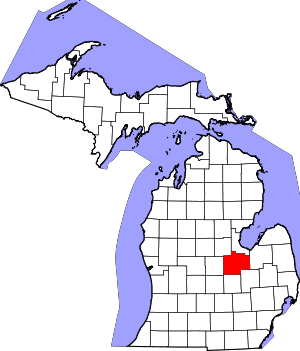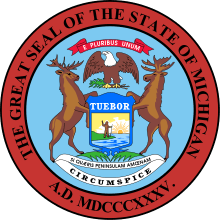Saginaw, Michigan
Saginaw (/ˈsæɡɪnɔː/) is a city in the U.S. state of Michigan and the seat of Saginaw County.[6] The city of Saginaw and Saginaw County are both in the area known as Mid-Michigan. Saginaw is adjacent to Saginaw Charter Township and considered part of the Great Lakes Bay Region, along with neighboring Bay City, Midland and Mount Pleasant. The Saginaw County MSA had a population of 196,542 in 2013.[7] The city is also the largest municipality in the Saginaw, Midland, and Bay City Metropolitan Area.
Saginaw, Michigan | |
|---|---|
| City of Saginaw | |
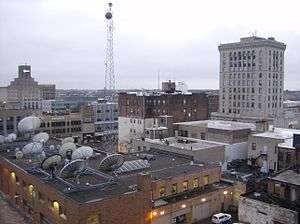 Downtown Saginaw as viewed from the Bearinger Building | |
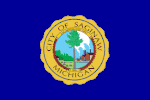 Flag  Seal  Logo | |
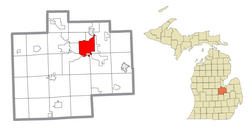 Location within Saginaw County | |
 Saginaw Location within the state of Michigan | |
| Coordinates: 43°25′04″N 83°57′52″W | |
| Country | United States |
| State | Michigan |
| County | Saginaw |
| Settled | 1819 |
| Incorporated | 1857 |
| Government | |
| • Type | Council–manager |
| • Mayor | Floyd Kloc |
| • City manager | Tim Morales |
| Area | |
| • City | 17.81 sq mi (46.13 km2) |
| • Land | 17.08 sq mi (44.24 km2) |
| • Water | 0.73 sq mi (1.88 km2) |
| Elevation | 584 ft (178 m) |
| Population | |
| • City | 51,508 |
| • Estimate (2019)[4] | 48,115 |
| • Rank | US: 736th |
| • Density | 2,849.61/sq mi (1,100.23/km2) |
| • Urban | 126,265 (US: 253rd) |
| • Metro | 196,542 (US: 219th) |
| Time zone | UTC−5 (EST) |
| • Summer (DST) | UTC−4 (EDT) |
| ZIP code(s) | 48601–48609, 48638, 48663 |
| Area code(s) | 989 |
| FIPS code | 26-70520 |
| GNIS feature ID | 1627020[5] |
| Website | Official website |
Saginaw was a thriving lumber town in the 19th century and an important industrial city and manufacturing center throughout much of the 20th century.[8] During the late 20th century, its industry and strong manufacturing presence declined, leading to increased unemployment, crime, and a population decline.[9] Neighboring communities, such as Saginaw Charter Township, saw subsequent population increases while the city itself is projected to return to normal population growth after the decades-long structural changes to the economy.[10]
Economic development is focused on comparative advantages in innovation, clean energy, and continued manufacturing exports. The city continues to have a higher proportion of manufacturing jobs than the US average.[11]
Etymology
The name Saginaw is widely believed to mean "where the Sauk were" in Ojibwe, from Sace-nong or Sak-e-nong (Sauk Town), due to the belief that the Sauk once lived there. But it is more likely that the name means "place of the outlet", from the Ojibwe sag (opening) and ong (place of).[12][13]
When Natives told Samuel de Champlain that the Sauk nation was on the western shore of Lake Michigan, Champlain mistakenly placed them on the western shore of Lake Huron. This mistake was copied on subsequent maps, and future references identified this as the place of the Sauks. Champlain himself never visited what is now Michigan.[14]
History
19th century
Early history
The site of what later became the city of Saginaw was originally inhabited by the Anishnabeg. French missionaries and traders first appeared in the area during the late 17th century and encountered the Ojibwe (Chippewa) living in the area. The first permanent settlement by those other than Native Americans was in 1816 when Louis Campau established a trading post on the west bank of the Saginaw River.[15] Shortly thereafter the United States established Fort Saginaw. Campau's trading post was also inhabited by Metis.
During Michigan's territorial period, a county and township government were organized at Saginaw. Growth of the settlement was fueled rapidly during the 19th century by the lumber industry. Saginaw was the site of numerous sawmills and served as a port for Great Lakes vessels. What is now the city of Saginaw resulted from the consolidation of the cities of East Saginaw and Saginaw City (West Side) in 1889.
Fort Saginaw
In 1819, Lewis Cass, in the Treaty of Saginaw, negotiated the prerogative for the United States to own and settle the area with the leaders of the Ojibwe. In 1820, Campau attempted to expand across to the east bank of the river but was rejected by the Chippewas. In 1822, the United States Army established a fort on the west bank of the Saginaw River and named it Fort Saginaw. Two companies were stationed at the fort. A group of investors purchased some land near the fort and had it platted under the name, Town of Sagana. Due to the extremely harsh seasons and illnesses, Fort Saginaw was abandoned by 1824.[15]
By the late 1820s, the American Fur Company was operating a post at Saginaw.
Few plots were sold and after the U.S. Army pulled out, the town languished for most of the following decade. The town was re-platted in December 1830, comprising riverfront from Cass Street, on the south, to Harrison Street, and north to Jefferson. These plots sold slowly. By 1835, only 24 plots had been sold and the remainder were transferred to a new owner, who made another plat in February 1837. However, the financial crisis of the Panic of 1837 dampened interest in purchasing properties. After selling only 58 of the 407 plots, the remainder was sold again in 1841.[16]
Native Americans
Saginaw was the location of the annual government payment to the Ojibwe and Ottawa of the area, starting in the 1830s. This also attracted many French-Canadian and Euro-American merchants, primarily involved in selling watered down whiskey.[17]
Lumber boom
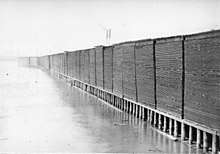
The main cause for the founding and subsequent development of Saginaw was the large demand for lumber as the United States expanded westward. A virgin growth forest principally consisting of white pine trees covered most of Michigan. The convenient access to transportation provided by the Saginaw River and its numerous tributaries fueled a massive expansion in population and economic activity. As the trees were being cut down in the region, logs were floated down the rivers to sawmills located in Saginaw, destined to be loaded onto ships and later railroad cars.
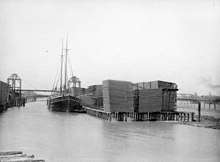
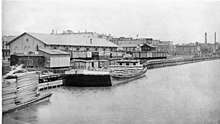
Multiple settlements comprise present-day Saginaw. On the west side of the river the first settlement around what had been Fort Saginaw developed into Saginaw, which was incorporated as a city in 1857, containing the seat of the Saginaw County government. On the east side of the river a parallel settlement, East Saginaw, developed which was incorporated first as a village in 1855, and then as a city in 1859. Also south of East Saginaw, on the east bank of the river, the village of Salina formed. Salina's name relates to the brine that led to a growing industry of salt production in the area. Both Saginaw and East Saginaw quickly became a hub for railroad transportation in addition to ships on the Saginaw River.
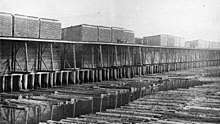

Lumber production peaked by the early 1870s, but had virtually disappeared by the end of the 19th century. In addition to salt production, which experienced an eventual decline as well, growing industries, such as those supporting the area's agriculture and manufacturing, developed.
Consolidation
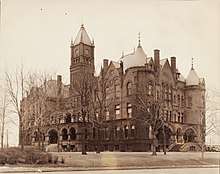
On June 28, 1889, the Michigan state legislature passed Act 455 to consolidate the cities of Saginaw and East Saginaw into a single city.[18][19] Prior to this consolidation, the nearby village of Salina had already become part of East Saginaw. The consolidation of Saginaw became effective with the election of officers on March 12, 1890.[19]
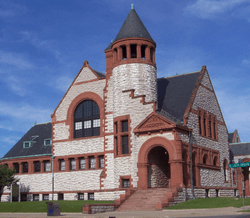
The provisions of the city charter were established by the same act of the legislature that provided for the consolidation. Saginaw was to be governed by a city council consisting of two aldermen elected from 21 wards and a mainly ceremonial executive mayor who was to have fairly weak powers. This was to be, as numerous other elected officials, along with elected or appointed boards, controlled much of the administrative and executive functions of government. The efficient and cohesive functioning of the Saginaw city government also was constrained by remaining rivalries between residents, business owners, and politicians from the former two cities. The distinctions and rivalries between Saginaw's east side and west side persisted into the 20th century in various forms, and continues to influence Saginaw's social, political, economic landscape, even into the 2010s.[20]
20th century
Industrialization
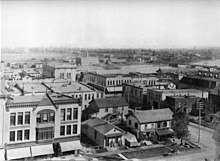
In the early 20th century, automobile production proliferated throughout Michigan, but most notably in Detroit. Other Michigan cities became suppliers to Detroit factories, sometimes with factories of their own. In Saginaw, the Jackson-Church-Wilcox Company began as a partnership in 1906 for producing steering gear under the "Jacox" brand. Jackson-Church-Wilcox was acquired by Buick in 1909, and as part of General Motors became the Jackson, Church and Wilcox Division, the first GM division devoted to parts production. In 1919 the Jacox division was merged with Saginaw Malleable Iron and Central Foundry into GM's Saginaw Products Company. This formed the basis for the Saginaw Steering Gear Division, created in 1928. General Motors and other manufacturers established foundries and other automobile-related manufacturing facilities in Saginaw, for the production of chemicals and plate glass, as well as metal fabrication. This early development of a symbiotic relationship with the auto industry set the course for the future of the city.[21]

New governance
In 1908, a new Michigan state constitution was adopted. The new Michigan state constitution mandated increased home rule powers for local units of government, and the Michigan state legislature enacted the Home Rule Cities Act in 1909. Under this statute, cities were permitted to frame and adopt their own city charters and were given great flexibility in structuring their local governments. The government, under the 1889 charter, had continued to be inefficient and provided for much political infighting. In 1913, a new city charter was adopted with voter approval and which followed a commission form of city government that had gained in popular interest among various cities across the United States in the early 20th century. The new government consisted of five commissioners, each elected separately at-large, who served both as the city council and as the executive heads of various city government departments. One of the commissioners served as the mayor, which was a mostly ceremonial role.
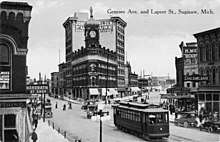
The 1913 city charter was followed for little more than two decades when the voters of the city again adopted another new city charter in 1935 following the council-manager form of government. The government under the 1913 city charter retained some of the independent boards that were given authority independent of the elected city commissioners. This caused some inefficiency and political friction. The economic consequences of the Great Depression during the 1930s provided the final catalyst for municipal government reform.
In contrast to the previous government structures, the 1935 charter, having taken effect in 1936, provided for all administration of city government to be headed directly by a single officer, the city manager, who was appointed by, and accountable to a city council of nine members elected as a group by the entire city at-large. The system was designed to address two principal issues with Saginaw's history of municipal government, the inefficiency and politics associated with having executive and administrative authority spread among many different officers and boards, and political rivalries and friction between various geographic areas of the city, mainly the east side and the west side.
Expansion and growth
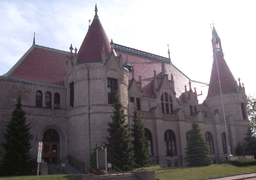
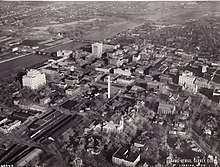
During much of the 20th century, Saginaw's economy was dominated by manufacturing related to the automotive industry; most notably, manual transmission assemblies, steering gear boxes and power steering pumps. At the height of manufacturing in the 1960s and 1970s, the city and neighboring Buena Vista Township hosted 12 General Motors plants, an Eaton Manufacturing plant (demolished 2008) where 5,000 people produced auto parts,[22] and numerous smaller concerns.
The General Motors plants in the county were:
- The original Jackson-Wilcox factory on Saginaw's North Hamilton (ca. 1906), later Saginaw Steering Gear Plant 1, closed 1984,[23] sold by GM in 1987 to Thomson Industries, still operating as of 2009.[24]
- Chevrolet Saginaw Parts at Sixth and Washington on Saginaw's East Side, built in 1906 as the assembly plant of the Rainier Motor Car Company, acquired by GM in 1907. Closed 1983, demolished 1984.[25]
- Saginaw Malleable Iron on the Southwest Side (1917). Contracted to build gear housings for GM's Jacox division (the former Jackson Wilcox company, later Saginaw Steering Gear), sold to GM in 1919, later part of Saginaw Products Division, reorganized into a new Central Foundry Division in 1946.[26] Closed May 2007,[27] razed in 2010 and for sale as of May 2013 by the RACER Trust, charged with disposing of abandoned GM properties.
- Chevrolet Grey Iron, on the North Side of Saginaw, opened as Central Foundry in 1918, operated by Chevrolet Division 1927–1983, thereafter by GM Powertrain Division. Operating today as Saginaw Metal Casting Operations,[28] the only GM manufacturing division still operating in Saginaw County.
- Chevrolet Saginaw Transmission on East Genesee in Saginaw, built 1919–20 for the Michigan Crankshaft Company, acquired by GM in 1921 and placed under Saginaw Products. Transferred to Chevrolet upon the dissolution of the Crankshaft Division (ca. 1927). Home of the Saginaw 3-speed and 4-speed manual transmissions. Transferred to the Delco Moraine Division in 1984, which became Delphi Automotive in 1995. After 2007, leased and later purchased outright by TRW Automotive, operating as TRW Braking and Suspension[29] until closing in February 2014.[30]
- Saginaw Steering Gear Plant 2, the "Gun Plant" (see below) adjacent to Malleable Iron; opened March 1941, closed July 2001, razed 2002.[31] For sale by RACER Trust as of May 2013.
- The 400-acre Saginaw Steering Gear complex in Buena Vista Township. Plant 3 opened 1953 next to the then-new US-23 bypass, adding Plants 4, 5 and 6 by 1966 and a seventh shortly thereafter. Later known as Saginaw Division, then part of Delphi, sold in 2010 to Nexteer Corporation,[22] is supplying GM, Ford and Chrysler as of 2013.[32]
- Chevrolet Nodular Iron in Buena Vista Township, built 1964–1965, entered production 1967, announced for closure 1986, closed 1988; since demolished.[23][33] Property for sale by RACER Trust as of May 2013.
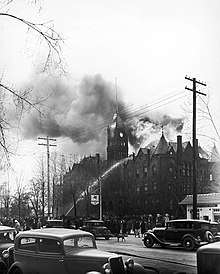
Before the United States entered World War II, Saginaw's industrial complex became directed towards military production. Turning its efforts to the production of munitions, ordnance and components for military vehicles made Saginaw a significant contributor to the Allies' victory. Saginaw was home to a production facility that produced .30 caliber machine guns more quickly and at lower cost than the Army thought possible, armor-piercing shells for anti-tank use,[34] and more than half a million M1 carbine rifles for the US military during World War II, the "Gun Plant" that later became Steering Gear Plant 2.[35] Saginaw Steering Gear's Plant 1 also began wartime production in 1941, concentrating on ball screws that would eventually be used in the wing flaps of the Boeing B-29 Superfortress.[24][36] Malleable Iron converted its production of Armasteel from engine components to gun parts and tank treads,[26] while Grey Iron specialized in the production of magnesium for use in Pratt and Whitney aeroplane engines.[28]
Migration from across the country, particularly from the Southern United States, drastically increased Saginaw's population during the war years and through the 1950s. This population growth included the expanded presence of African Americans and Latinos in Saginaw. Even before the end of the war, the needs of Saginaw's growth became clear, and were met by significant investment in the city's infrastructure. In 1947, Saginaw and the nearby city of Midland constructed a 65-mile-long (105 km) water supply pipeline drawing water from Whitestone Point in Lake Huron to meet the anticipated needs of the communities. In addition, the cities of Midland and Bay City joined with Saginaw to develop and operate an airport on the site of a former POW camp in nearby Tittabawassee Township, which eventually became MBS International Airport.
Post World War II
In the years following World War II, the Michigan state legislature enacted laws making it increasingly difficult for incorporated cities to expand by annexing territory from neighboring townships. Townships, which had historically served an agrarian, smaller population than that of larger cities, were given the ability to provide nearly all the same services an incorporated city could. Although Midland pursued (and continues to pursue) a policy of "No annexation, no water,"[37] Saginaw chose to sell water to neighboring communities under long-term contracts. This allowed the townships to further develop at the expense of the city, the limits of which changed little after consolidation in 1989–90. The unintended consequence of this choice was that Saginaw's population stopped growing, new housing development focused on the suburban townships, and businesses eventually followed.
21st century
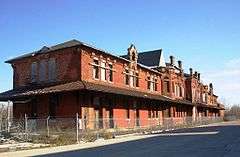
Population decline
Manufacturing in Saginaw declined in the latter half of the 20th century, leading to high unemployment in the city. As a result, the city's population diminished dramatically. From 2000 to 2010, the population of Saginaw proper decreased by nearly 10,000. Michigan's population during that period decreased by 0.6% percent, the only U.S. state to lose population during the decade of the 2000s. In addition, Saginaw has faced increasing social problems relating to poverty as a result of its high rate of unemployment. The crime rate has been a major area of concern for the community.[38]
Unemployment and crime
Saginaw's economic conditions, compounded by the 2007–2012 global financial crisis, are a significant area of concern for the city's residents. The decline of manufacturing jobs has resulted in higher than average rates of unemployment. Property values in the city have declined, decreasing the amount the city government collects in property taxes. Unemployment in Saginaw peaked in July 2009, according to the Bureau of Labor Statistics, standing at 23.5%. The unemployment rate dropped to 9.0% as of April 2015; crime has decreased as unemployment has decreased.
Combating blight
Unemployment and population loss in the late 20th and early 21st centuries has led to urban blight, specifically a rise in abandoned homes that provided locations for criminal activity. In recent years, city officials, law enforcement, and neighborhood watch associations have made progress in preventing this activity by heavily patrolling target areas and offering rewards for reporting illegal or suspicious activities.
Efforts to reduce blight in Saginaw increased greatly in 2013, with the United States Department of the Treasury approving a grant to demolish vacant and abandoned properties via the Michigan State Housing Development Authority. The $100 million grant contained $11.2 million set aside for Saginaw, with Detroit receiving $52.3 million, Flint $20.1 million, Pontiac $3.7 million, and the final $2.5 million going to Grand Rapids.[39]
Michigan Governor Rick Snyder praised the initiative, saying, "With these federal funds, we'll be able to launch large-scale demolition programs that strike at the blight that is weakening too many neighborhoods in these cities." He added, "This aggressive anti-blight effort will help stabilize neighborhoods that have been struggling for years. As the abandoned properties come down, property values will go up, and crime will go down. That will encourage the people who live in these neighborhoods to stay in their homes and be part of the revitalization of their communities."[39]
The Saginaw city government can legally tear down only publicly owned properties, a number that stands above 400. The federal grant provides funds to demolish nearly 950 structures. After the grant's approval, Saginaw city officials announced a program to purchase unwanted, abandoned structures from their owners, which would be then added to the list of homes to tear down. Officials estimate that there are nearly 1,200 privately owned homes within the city limits that are worthy of demolition.[40]
Efforts to revitalize downtown increased in 2013. CBS television executive and Saginaw native David Strouse announced an investment plan in late 2013 that would save nearly an entire block of buildings slated for demolition at the intersection of Washington and Genesee, the core of downtown Saginaw. The plan called for the renovation and redevelopment of four buildings, creating market-rate apartments on the upper floors and retail space at ground level. In 2012 a similar deal was made for the Bancroft and Eddy apartments at the same intersection. Once Section 8 housing, these buildings are being transformed into market-rate apartments and retail space.[41]
Recent economic development
Economic development in the region is focused on comparative advantages in innovation, clean energy, and continued manufacturing exports. Compared to other mid-sized communities, Saginaw has a high number of patent applications per job, and more than 81 times the average US share of jobs in photovoltaic technology research and production. The city continues to have a higher proportion of manufacturing jobs than the US average.[42]
Geography
Topography
According to the U.S. Census Bureau, the city has a total area of 18.10 square miles (46.88 km2), of which, 17.34 square miles (44.91 km2) is land and 0.76 square miles (1.97 km2) is water.[43] Saginaw lies on the Saginaw River, 15 miles (24 km) inland from the Saginaw Bay, an arm of Lake Huron.
Climate
Saginaw has a humid continental climate influenced by its inland position not on the shore of one of the Great Lakes of Michigan.[44]
| Climate data for Saginaw, Michigan (MBS International Airport), 1981–2010 normals,[45] extremes 1898–present | |||||||||||||
|---|---|---|---|---|---|---|---|---|---|---|---|---|---|
| Month | Jan | Feb | Mar | Apr | May | Jun | Jul | Aug | Sep | Oct | Nov | Dec | Year |
| Record high °F (°C) | 62 (17) |
67 (19) |
87 (31) |
89 (32) |
95 (35) |
104 (40) |
111 (44) |
103 (39) |
100 (38) |
91 (33) |
80 (27) |
67 (19) |
111 (44) |
| Mean maximum °F (°C) | 47.0 (8.3) |
48.9 (9.4) |
66.4 (19.1) |
78.8 (26.0) |
85.3 (29.6) |
92.4 (33.6) |
92.5 (33.6) |
90.8 (32.7) |
86.4 (30.2) |
77.9 (25.5) |
64.8 (18.2) |
50.4 (10.2) |
92.5 (33.6) |
| Average high °F (°C) | 28.9 (−1.7) |
31.7 (−0.2) |
42.2 (5.7) |
56.1 (13.4) |
68.0 (20.0) |
77.9 (25.5) |
81.8 (27.7) |
79.4 (26.3) |
72.1 (22.3) |
59.3 (15.2) |
45.9 (7.7) |
33.5 (0.8) |
56.4 (13.6) |
| Average low °F (°C) | 15.6 (−9.1) |
17.3 (−8.2) |
25.3 (−3.7) |
36.0 (2.2) |
46.6 (8.1) |
56.5 (13.6) |
60.2 (15.7) |
58.3 (14.6) |
50.5 (10.3) |
40.1 (4.5) |
31.2 (−0.4) |
21.2 (−6.0) |
38.2 (3.5) |
| Mean minimum °F (°C) | −3.6 (−19.8) |
−1.2 (−18.4) |
6.2 (−14.3) |
23.1 (−4.9) |
33.4 (0.8) |
43.2 (6.2) |
47.9 (8.8) |
46.4 (8.0) |
35.9 (2.2) |
27.2 (−2.7) |
17.7 (−7.9) |
3.6 (−15.8) |
−3.6 (−19.8) |
| Record low °F (°C) | −22 (−30) |
−23 (−31) |
−12 (−24) |
8 (−13) |
24 (−4) |
33 (1) |
39 (4) |
37 (3) |
27 (−3) |
0 (−18) |
−3 (−19) |
−12 (−24) |
−23 (−31) |
| Average precipitation inches (mm) | 1.71 (43) |
1.61 (41) |
2.06 (52) |
2.89 (73) |
3.38 (86) |
2.98 (76) |
2.58 (66) |
3.31 (84) |
3.83 (97) |
2.63 (67) |
2.70 (69) |
1.86 (47) |
31.54 (801) |
| Average snowfall inches (cm) | 11.9 (30) |
8.6 (22) |
6.4 (16) |
1.7 (4.3) |
0.0 (0.0) |
0.0 (0.0) |
0.0 (0.0) |
0.0 (0.0) |
0.0 (0.0) |
0.3 (0.76) |
3.6 (9.1) |
9.0 (23) |
41.5 (105.16) |
| Average precipitation days (≥ 0.01 in) | 10.6 | 8.6 | 9.2 | 11.4 | 10.7 | 9.8 | 9.1 | 10.4 | 10.4 | 10.7 | 11.4 | 11.2 | 123.5 |
| Average snowy days (≥ 0.1 in) | 8.8 | 6.1 | 4.1 | 1.3 | 0.0 | 0.0 | 0.0 | 0.0 | 0.0 | 0.2 | 2.4 | 7.5 | 30.4 |
| Source: NOAA[46][47] | |||||||||||||
Demographics
| Historical population | |||
|---|---|---|---|
| Census | Pop. | %± | |
| 1860 | 1,699 | — | |
| 1870 | 7,460 | 339.1% | |
| 1880 | 10,525 | 41.1% | |
| 1890 | 46,322 | 340.1% | |
| 1900 | 42,345 | −8.6% | |
| 1910 | 50,510 | 19.3% | |
| 1920 | 61,903 | 22.6% | |
| 1930 | 80,715 | 30.4% | |
| 1940 | 82,794 | 2.6% | |
| 1950 | 92,918 | 12.2% | |
| 1960 | 98,265 | 5.8% | |
| 1970 | 91,849 | −6.5% | |
| 1980 | 77,508 | −15.6% | |
| 1990 | 69,512 | −10.3% | |
| 2000 | 61,799 | −11.1% | |
| 2010 | 51,508 | −16.7% | |
| Est. 2019 | 48,115 | [4] | −6.6% |
| U.S. Decennial Census[48] 2018 Estimate[49] | |||
Saginaw is the largest principal city of the Saginaw-Midland-Bay City, MI CSA, a Combined Statistical Area that includes the Saginaw-Saginaw Township North (Saginaw County), Midland (Midland County), and Bay City (Bay County) metropolitan areas,[50][51] which had a combined population of 380,535 at the 2010 census.
2010 census
As of the census[3] of 2010, there were 51,508 people, 19,799 households, and 12,252 families residing in the city (excludes townships). The population density was 2,970.5 inhabitants per square mile (1,146.9/km2). There were 23,574 housing units at an average density of 1,359.5 per square mile (524.9/km2). The racial makeup of the city was 46.1% African American, 43.5% White, 0.5% Native American, 0.3% Asian, 5.2% from other races, and 4.4% from two or more races. Hispanic or Latino of any race were 14.3% of the population.
There were 19,799 households, of which 36.0% had children under the age of 18 living with them, 26.9% were married couples living together, 28.7% had a female householder with no husband present, 6.3% had a male householder with no wife present, and 38.1% were non-families. 32.1% of all households were made up of individuals, and 9.5% had someone living alone who was 65 years of age or older. The average household size was 2.52 and the average family size was 3.19.
The median age in the city was 33.5 years. 28.4% of residents were under the age of 18; 10.6% were between the ages of 18 and 24; 25.1% were from 25 to 44; 25% were from 45 to 64; and 10.9% were 65 years of age or older. The gender makeup of the city was 47.1% male and 52.9% female.
2000 census
As of the census of 2000, there were 61,799 people, 23,182 households, and 15,114 families residing in the city. The population density was 3,542.9 people per square mile (1,368.2/km2). There were 25,639 housing units at an average density of 1,469.9 per square mile (567.6/km2). The racial makeup of the city (excluding townships) was 47.02% White, 43.26% African American, 0.49% Native American, 0.33% Asian, 0.02% Pacific Islander, 5.86% from other races, and 3.03% from two or more races. Hispanic or Latino of any race were 11.75% of the population.
There were 23,182 households, out of which 35.4% had children under the age of 18 living with them, 32.9% were married couples living together, 27.3% had a female householder with no husband present, and 34.8% were non-families. 29.5% of all households were made up of individuals, and 9.9% had someone living alone who was 65 years of age or older. The average household size was 2.60 and the average family size was 3.23.
In the city, the population was spread out, with 31.6% under the age of 18, 9.9% from 18 to 24, 28.3% from 25 to 44, 18.7% from 45 to 64, and 11.4% who were 65 years of age or older. The median age was 31 years. For every 100 females, there were 87.2 males. For every 100 females age 18 and over, there were 81.0 males.
The median income for a household in the city was $26,485, and the median income for a family was $29,945. Males had a median income of $31,614 versus $22,714 for females. The per capita income for the city was $13,816. About 24.7% of families and 28.5% of the population were below the poverty line, including 40.2% of those under age 18 and 16.3% of those age 65 and over.
Government
Saginaw is classified as a Home Rule City under the Michigan Home Rule Cities Act adopting its own City Charter giving its city a council-manager form of government. The present Charter was adopted in 1935 and took effect on January 6, 1936. Pursuant to the City Charter, Saginaw is governed by a nine-member elected at-large Council. The term of office for a member of the City Council is four years commencing with the first meeting following a regular municipal election. The terms are staggered so the entire Council is not subject to re-election at the same time—either four or five members are elected in each odd-numbered year. The city levies an income tax of 1.5 percent on residents and 0.75 percent on nonresidents.[52]
Healthcare
Aleda E. Lutz Veterans Affairs Medical Center, located at 1500 Weiss, is a hospital serving America's Veterans overseen by the Veterans Health Administration. It has 100 staffed beds, and sees 292,000 patients a year.[53]
Covenant Medical Center, located at 1447 North Harrison, is a 623-bed hospital with inpatient and outpatient facilities including an emergency department that provides 85,000 visits per year.[54] It is the location for "CMU Medical Education Partners", which offers various residency training programs.[55] It also offers walk-in clinics and facilities scattered throughout the county for outpatient surgery, breast cancer diagnosis, physical therapy, sports medicine and eye care.
Ascension Saint Mary's of Michigan, located at 800 South Washington, is a hospital with approximately 225 staffed beds, and sees 168,000 patients a year.[53] St. Mary's treats trauma, heart disease and cancer among other ailments and opened its Ambulatory Care Center in Saginaw Township in 2000 featuring the county's first suburban emergency room.
Health Delivery Inc is a downtown based nonprofit organization offering a network of federally funded health centers reaching 37,000 low income individuals and migrant workers.
A healthcare hub on South Washington Avenue is anchored by the Michigan Cardiovascular Institute which treats patients from around the state.
Education
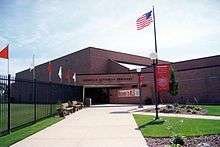
Higher education
Saginaw is served by Delta College and Saginaw Valley State University, which are located in nearby University Center, Michigan. Central Michigan University maintains an off-campus center inside the city that offers numerous degree programs. Delta College built a downtown satellite facility that opened in the fall of 2019.
Primary and secondary schools
The city of Saginaw is served by the Saginaw Public School District, also known as SPSD. The Saginaw Public School District operates twelve elementary schools, two combined elementary/middle schools, two middle schools, one combined middle/high school, and two high schools. The district is governed by a seven member elected board of education. The board selects a superintendent for the district. The current superintendent is Mr. Nathan Mcclain.[56] The three public high schools in Saginaw are Arthur Hill High School, Saginaw High School, and the Saginaw Arts and Sciences Academy. Michigan Lutheran Seminary is the lone private high school in the city. Charter schools in the city are Saginaw Learn to Earn Academy, North Saginaw Charter Academy, Francis Reh Academy, Saginaw Prep schools, and the International Academy of Saginaw.
Business and commerce
The Saginaw metropolitan area's main shopping district is located in neighboring Saginaw Township along Bay Rd. and Tittabawassee Road north of town, where several big box stores and regional restaurant chains can be found. Also in the same area is Fashion Square Mall, a regional shopping mall anchored by JCPenney, Macy's, and Sears. Primary areas within the city of Saginaw for consumer shopping include Old Town and downtown.
Infrastructure

Utilities
The City of Saginaw gets its electricity and natural gas from Consumers Energy.
Municipal water supply
In 1929, the city opened its consolidated water works plant which replaced two separate plants that were on each side of the Saginaw river. This plant treated water brought in from the Saginaw river and piped it out to the residents as well as corner pumps for people that did not have direct connections to the system.[57] Currently, the City of Saginaw jointly owns with the City of Midland the Saginaw-Midland Municipal Water Supply Corporation. Incorporated in 1946, this water treatment system has supplied drinking and industrial water to both cities and many surrounding areas within the county.[58] Due to brackish water in the aquifers below both cities, a 65-mile-long (105 km) pipeline was constructed in 1948 to supply water from Lake Huron at White Stone Point, north of Au Gres to water treatment plants in Saginaw and Midland[57] with a second pipe added by 1996. This system has played a role in the decline of the city. The City of Saginaw, in order to obtain new sources of revenue, sold water to areas outside of the city (especially to the Saginaw Charter Township). This caused numerous businesses inside the city to leave for the surrounding areas and development in the city to stagnate. The City of Midland, however, adopted a policy of "No Annexation, No Water" which has led to the growth of the city as well as the surrounding areas.[58]
Neighborhoods
The City of Saginaw consists of many diverse neighborhoods,[59] including:
- Downtown
- Old Town[60][61]
- Southwest Village[59]
- Northmoor[62]
- Heritage Square[63]
- Cathedral District[64]
- Houghton Jones Neighborhood[65]
- South East Side[59]
- Triangle Parks[59]
- St. Stephen's Area[59]
- Brockway-Carmen Park[59]
- Butman-Fish Neighborhood[59]
- Redeemer Area[59]
- Saginaw High Neighborhood[59]
- Northeast Side[66]
- Covenant Neighborhood[67]
- Northwest Neighborhood[59]
- Sheridan Park[68]
- The Woods[69]
Transportation
Historically, ships were able to move along the length of the river inside the city, but fixed bridges built over the river closed access south of the northern docks.
Saginaw was a railroad hub to the Pere Marquette Railway. Freight and passenger routes radiated to Bay City to the north, Port Huron to the east, Toledo to the south, Grand Rapids and Chicago to the southwest and Ludington to the west.[70][71][72] Grand Trunk Railroad ran trains from Bay City through Saginaw to Durand, for connections to Chicago, Detroit, Port Huron and Toronto.[73] Most passenger routes were discontinued during the 1950s. The last route to Potter Street Station was in 1950. The station was designated a historic site in 1991.[74] The last New York Central Railroad train (formerly Michigan Central Railroad) departed the Genesee Street Station bound for Detroit in 1964. Today, Saginaw hosts the headquarters of the Lake State Railway who continues to operate trains out of the massive former Pere Marquette Saginaw Yard to destinations that include Midland, Bay City and Plymouth. The Huron and Eastern Railroad operates the former GTW mainline through the city, which intersects with Lake State's Midland Line at Mershon Junction. HESR also operates several lines east into the thumb region towards Vassar and Reese. The Mid-Michigan Railroad plays a bit part in the region as well, interchanging with Lake State at Paines, west of the city. The Saginaw Railroad Museum, located on the west side of the city, continues to work towards preservation of the Saginaw Bay area's railroading history.z
Saginaw is served primarily by two airports: MBS International Airport, located in nearby Freeland, and Bishop International Airport, located in Flint. Saginaw is also served by three smaller airports: Harry W. Browne Airport in adjacent Buena Vista Township, James Clements Municipal Airport in Bay City, and Jack Barstow Municipal Airport in Midland.
Interstate 75 (I-75) serves as the main arterial route for the Saginaw area while I-675 provides direct access to the center of the city from I-75. I-69 is a nearby east–west corridor providing access to the rest of the Midwestern United States and Canada. The Saginaw River runs through the middle of the city and provides access to Saginaw Bay and the rest of the Great Lakes via docks on the northern side of the city.
In the city and surrounding areas, mass transit is provided by bus under the authority of the Saginaw Transit Authority Regional Services (STARS) system.[75] The STARS system connects to Bay City's Bus system at Saginaw Valley State University.
Intercity Bus Service is Provided by Indian Trails, which operates a bus station on the east side of the river.
Major highways









Culture
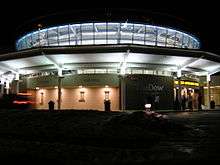
Saginaw's entertainment hub can be found in the downtown area, where venues such as The Dow Event Center and the restored Temple Theatre offer live entertainment. The Saginaw Bay Symphony Orchestra and Saginaw Choral Society are housed in the Temple and each of these organizations perform full concert series annually at the Temple venue. The Saginaw Historical Society is also located downtown in an elaborate castle. Nearby, the Saginaw Art Museum boasts an impressive permanent collection and recently underwent a massive renovation. The Celebration Square area of downtown boasts an authentic Japanese Tea House, the only one of its kind in Michigan. The Andersen Enrichment Center and Rose Gardens are another attraction in Celebration Square offering ongoing art exhibits, a summer jazz concert series, and winter and summer art fairs. Numerous other arts and cultural organizations serve the community including the Saginaw Arts & Enrichment Commission, Eddy Band, Holidays in the Heart of the City, River Junction Poets, Theodore Roethke House of Poetry, Riverside Film Festival, Lawn Chair Film Festival, Friday Night Live Concerts, River Junction Poets and Saginaw Area Watercolor Society. The Dow Event Center is home to the city's junior ice hockey team, the Saginaw Spirit of the Ontario Hockey League as well as The Saginaw Sting, an indoor football team. Downtown Saginaw has undergone a resurgence with locally owned restaurants and coffee shops dotting the area. The downtown Saginaw area contains a number of office buildings from the late 19th century and early 20th century. They are located near the Saginaw Club, a social club founded in 1889. In December 2016 "The Gallery: Art For Saginaw" opened in the newly redeveloped downtown. At roughly 5,000 square feet it is one of the largest public art galleries in the state of Michigan. The Downtown Farmer's Market offers Michigan produce, flowers, and baked goods from local bakeries and will be moving to an indoor permanent location in 2017. Downtown is not to be confused with the Old Town/West Side City area located on the other side of the river and about one mile (1.6 km) southwest. Old Town is home to many popular bars, locally owned restaurants, and businesses including its anchor business, Stable Outdoor Outfitters. The city's roster of local arts organizations includes Pit and Balcony, one of the oldest continuously operating community theaters in the United States, founded in 1932.[77]
Sports
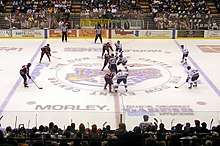
The Saginaw area is home to two professional sports teams and one NCAA Division-II school that has various sports programs. The Saginaw Spirit is an Ontario Hockey League team that became nationally known when television personality Stephen Colbert promoted the team on his show, The Colbert Report.[78] The Saginaw Sting was an indoor football team that formed in 2007 to play in Saginaw beginning in the 2008 season and is currently on hiatus.[79] At the collegiate level, Saginaw Valley State University competes in numerous sports such as American Football, Basketball, and Volleyball.[80]
| Team | Sport | League | Year founded | Venue |
|---|---|---|---|---|
| Saginaw Spirit | Ice hockey | Ontario Hockey League | 2002 | Dow Event Center |
| Saginaw Valley State University | Various | Great Lakes Intercollegiate Athletic Conference | 1963 | SVSU Campus |
Parks and museums
The Castle Museum of Saginaw County History is an important and prominent museum in downtown Saginaw. The museum is housed in a former post office which was built to resemble a castle, and pays homage to the historical French heritage of the area. With more than 100,000 artifacts in their collection, the Historical Society of Saginaw County displays items from their collection as well as those of traveling exhibits.[81]
The Andersen Enrichment Center and Lucille E. Andersen Memorial Rose Garden are part of the Saginaw's park system. The facility is used to host private and public events throughout the year. These events include Hollyday Art Fair, Art & Garden Festival, the SAWA Fall Watercolor Exhibition, Jazz in the Rose Garden and Art @ the Andersen[82] and a World AIDS Day service[83] The garden includes a fountain with a sculpture by Marshall Fredericks.
The Saginaw Art Museum hosts temporary exhibitions and permanent collections. The museum also houses The John and Michele Bueker Research Library and Archives of Michigan Art. The museum originated as the home of C.L. Ring who commissioned Charles A. Platt to design the house and gardens. The museum opened to the public in 1948. The museum is a Smithsonian Institution affiliate.[84]
Saginaw is home to a Japanese Cultural Center, Tea House and Garden, as a result of its 52-year Sister-City relationship with Tokushima, Japan. The Garden was completed in 1971. The Tea House, known as Saginaw Awa An, completed in 1986, is considered to be one of the ten most authentic Tea Houses outside the country of Japan. The site is open from April through October, and offers traditional tea ceremonies by appointment, and on the second Saturday of each month. Each year in September a Japan Festival is held in the garden, featuring authentic Japanese singers, dancers and performers, and offering demonstrations of Japanese Culture to those in attendance, including flower arranging, calligraphy, origami, and authentic Japanese cuisine, such as sushi and other dishes.
The city is also home to the Theodore Roethke Home Museum, a National Literary Landmark. The museum honors one of America's greatest 20th Century poets, who was born and raised in Saginaw.
Media
Television stations
Saginaw is part of Nielsen's Flint-Saginaw-Bay City-Midland Designated Market Area which is the 66th largest market in the United States for Television Viewers.[85] Saginaw is the home of CBS affiliate WNEM which maintains its studios and offices inside the city though its license is for Bay City, MI.[86] ABC affiliate WJRT maintains its offices and newsrooms in Saginaw while its studios are in its community of license, Flint.[87] Only NBC affiliate WEYI and Christian station WAQP have the City of Saginaw as their city of record but both maintain their facilities outside of the city.[88][89] Charter Communications operates a cable television network servicing the City of Saginaw under a franchise agreement.
| Television stations in the Saginaw, Michigan area (Ascending order) | |||||
|---|---|---|---|---|---|
| Channel | Call letters | Description | Comments | ||
| 5 | WNEM-TV | CBS affiliate | Licensed to Bay City; studios in Saginaw | ||
| 12 | WJRT-TV | ABC affiliate | Based and licensed in Flint | ||
| 19 | WDCQ-TV | PBS member station | Licensed to Bad Axe; studios at Delta College in University Center | ||
| 24 | W24DL-D | 3ABN affiliate | Based and licensed in Saginaw; programmed via satellite | ||
| 25 | WEYI-TV | NBC affiliate | Licensed to Saginaw; studios in Clio | ||
| 46 | WBSF | CW affiliate | Licensed to Bay City; studios in Clio | ||
| 49 | WAQP | TCT O&O affiliate | Based and licensed in Saginaw | ||
| 66 | WSMH | Fox affiliate | Based and licensed in Flint | ||
Radio stations
Saginaw and Saginaw Township are home to the three major radio station clusters serving the Greater Tri Cities. Those include family owned and Saginaw-headquartered MacDonald Broadcasting, and corporate broadcasters Alpha Media and Cumulus Media. Radio stations licensed within the immediate Saginaw area are listed. Many locations in the City of Saginaw also receive stations from Bay City, Midland, Flint, and Lansing.
| AM radio stations | |||||
|---|---|---|---|---|---|
| Frequency | Call sign | Name | Format | Owner | City |
| 790 AM | WSGW | Newsradio 790 | News/Talk | Alpha Media | Saginaw |
| 1250 AM | WJMK | MeTV FM | Oldies | Northern States Broadcasting Corporation | Bridgeport |
| 1400 AM | WSAM | The Bay 1400 AM and 104FM | Adult Contemporary | MacDonald Broadcasting | Saginaw |
| FM radio stations | |||||
|---|---|---|---|---|---|
| Frequency | Call sign | Name | Format | Owner | City |
| 90.9 FM | WTRK | Air 1 | Contemporary Christian | Educational Media Foundation | Freeland |
| 93.3 FM | WKQZ | The Rock Station, Z93 | Modern rock | Cumulus Media | Midland; studios in Saginaw |
| 93.7 FM | WRCL | Club 93.7 | Rhythmic contemporary | Townsquare Media | Frankenmuth; studios in Burton |
| 94.5 FM | WCEN-FM | 94.5 The Moose | Country music | Alpha Media | Hemlock; studios in Saginaw |
| 96.1 FM | WHNN | My 96.1 | Adult Contemporary | Cumulus Media | Bay City; studios in Saginaw |
| 98.1 FM | WKCQ | 98.1 KCQ | Country music | MacDonald Broadcasting | Saginaw |
| 100.5 FM | WSGW-FM | FM Talk 100.5 | News/Talk | Alpha Media | Carrollton; studios in Saginaw |
| 102.5 FM | WIOG | The Hit Music Channel | Contemporary hits | Cumulus Media | Bay City; studios in Saginaw |
| 104.5 FM | WILZ | Wheelz 104.5 | Classic rock | Cumulus Media | Saginaw |
| 106.3 FM | WGER | The New Mix 106.3 | Adult contemporary music | Alpha Media | Saginaw |
| 107.1 FM | WTLZ | KISS 107.1 | Urban adult contemporary | Alpha Media | Saginaw |
In popular culture
- Saginaw is referred to in the Simon & Garfunkel song "America": "It took me four days to hitchhike from Saginaw, I've gone to look for America."[92]
- Saginaw is referred to in the Brian D'Arcy James song: "Michigan Christmas". Brian grew up in Saginaw, Michigan.[93]
- Bill Anderson and Don Wayne wrote a song entitled "Saginaw, Michigan" which has been covered by a dozen artists.[94] Cowboy singer Lefty Frizzell was the first to perform it, with his version reaching number one on the country charts.[95][96] Also popularly, it was performed by George Jones.[upper-alpha 1]
- Saginaw served as the destination point for the Seinfeld characters Kramer and Newman during an episode where the pair hatched a scheme to transport bottles and cans via a United States Postal Service mail truck from New York to Michigan to earn 10¢ per recycled item, as opposed to New York's 5¢.[97]
- In an episode of the Disney Channel sitcom Even Stevens, the title family's patriarch Steve, played by Tom Virtue, declares that he is a native of Saginaw.
- In an episode of The CW Television Network's television series, Supernatural, brothers Sam and Dean investigate a murder meant to look like a suicide in Saginaw.[98]
- "The Saginaw Song" is the title of a poem by Theodore Roethke, a poet who was born in Saginaw in 1908.[99]
- Saginaw and the Saginaw Valley was a center for songwriting. The well-known tunes "All of Me" "Toot Toot Tootsie" "It Had to Be You" "After the Ball" "I'm Forever Blowing Bubbles" "Stand Up Stand Up for Jesus" and many others were either written or co-written by songwriters from Saginaw. More modern examples include "Only Women Bleed" and the catalog of Saginaw native Steveland Morris, aka Stevie Wonder, Dick Wagner, and Rudy Martinez ("96 Tears")[100]
- In Charles Baxter's 1985 short story "Gryphon" a character named Miss Ferenczi mentions moving north from Detroit "to dreadful Saginaw".
Notable people
Sister cities




See also
Notes
- The song mis-situates the city on Saginaw Bay, about 15 miles to the north.
References
- "2017 U.S. Gazetteer Files". United States Census Bureau. Retrieved Jan 3, 2019.
- "USGS Detail on Saginaw, MI". Retrieved 2007-11-26.
- "U.S. Census website". United States Census Bureau. Retrieved 2012-11-25.
- "Population and Housing Unit Estimates". Retrieved May 21, 2020.
- "Saginaw". Geographic Names Information System. United States Geological Survey.
- "About Saginaw County, MI". National Association of Counties. Archived from the original on 2007-10-18. Retrieved 2007-11-26.
- Doe, John (27 March 2014). "State and County Quick Facts: Saginaw County, MI". United States Census. Open Publishing. Retrieved 15 April 2014.
- "The Saginaw Lumber Boom (1850–1894)". Michigan State University.
- "A Brief History of Lumbering in Michigan". Michigan Center for History Studies. Retrieved 2007-11-27.
- 2040 Metropolitan Transportation Plan (PDF) (Report). Saginaw County Metropolitan Planning Commission. 5 May 2012. Retrieved 15 April 2014.
- Michigan Economics Condition Assessment: Flint, Kalamazoo, Holland, And Saginaw (PDF) (Report). Brookings Institution. 2012. Retrieved 15 April 2014.
- "Clarke Home—entral Michigan University". cmich.edu.
- Michigan Counties. DNR. Retrieved 2012-11-05.
- Saginaw's Changeable Past, by Jeremy W. Kilar, G. Bradley, St. Louis, MO, 1994, p. 15
- Manning, Nancy Sajdak. "West Side, East Side". Great Lakes Bay Magazine (June 2014). Great Lakes Publishing. Retrieved January 22, 2015.
- Leeson, Michael A. (2005) [1881]. History of Saginaw county, Michigan. Ann Arbor, Mich.: University of Michigan Library. pp. 596+. Retrieved 2007-04-11.
- History of Saginaw County, Michigan (Chicago: Charles A. Chapman, 1881) p. 122–123
- "Minutes of City Council Meeting—June 27, 2005". Retrieved 2007-11-29.
- "City Charter Preface". Retrieved 2007-11-29.
- Thompson, Mike (June 2007). "Saginaw Celebrates its 150th Birthday!". Review Magazine. 29 (641). Archived from the original on 2007-10-22. Retrieved 2007-11-29.
- "Saginaw Steering Division—Generations of GM". Retrieved 2012-06-23.
- White, Joseph B. (11 February 2012). "In the Heart of the Rust Belt, Chinese Funds Provide the Grease". The Wall Street Journal. Retrieved 13 May 2013.
- "GM TO CLOSE FOUNDRY IN MICHIGAN, CUT MOST JOBS AT NEW YORK FOUNDRY PRECEDE SAGINAW". Associated Press. 6 August 1986. Retrieved 12 May 2013.
- "About Us". Thomson Aerospace and Defense. Retrieved 13 May 2013.
- Lynch-Morin, Kathryn (18 May 2010). "Trust fund to pay for cleaning old GM sites, including Saginaw". The Saginaw News. Retrieved 13 May 2013.
- Bowman, Bill. "Central Foundry Division". GM Heritage Center. Retrieved 12 May 2013.
- Engel, Justin (24 January 2010). "Leaders ponder Saginaw Malleable foundry's fate". The Saginaw News. Retrieved 12 May 2013.
- McFarland, Jodi (1 June 2009). "Saginaw Metal Castings Operations timeline". The Saginaw News. Retrieved 12 May 2013.
- "Our Location [sic]". TRW Automotive Holdings. Retrieved 13 May 2013.
- "TRW confirms plans to close Saginaw plant in mid-February". Mlive.com. Retrieved 3 January 2014.
- Roesner, Joshua (26 December 2012). "Saginaw Steering Gear Plant 2 lives on as former employees gather more than a decade after factory razed". Saginaw News. Retrieved 12 May 2013.
- Roush, Matt (30 April 2013). "Tech Tour Day Five: Tri-Cities Terrific". WWJ News 62. Retrieved 12 May 2013.
- "Chevrolet Nodular Iron Casting Plant" (PDF). (brochure, ca. 1976). Chevrolet Motor Division. Retrieved 12 May 2013.
- Rogers, Dave (22 April 2012). "Why Did U.S. Win WW II? Saginaw Gun Plant Personified Patriotic Production". MyBayCity.com. Retrieved 13 May 2013.
- "A Pocket History of the M1 Carbine". Archived from the original on 2007-10-12. Retrieved 2007-11-29.
- Herman, Arthur. Freedom's Forge: How American Business Produced Victory in World War II, pp. 110-11, 146, 216, Random House, New York, NY, 2012. ISBN 978-1-4000-6964-4.
- "The Midland Urban Growth Area (MUGA)". City of Midland Planning Department. Retrieved 13 May 2013.
- "Census 2010 News U.S. Census Bureau Releases Data on Population Distribution and Change in the U.S. Based on Analysis of 2010". Archived from the original on 16 October 2011. Retrieved 23 June 2012.
- Oosting, Jonathan (2013-08-20). "Detroit, Flint and Saginaw get bulk of federal funds awarded to fight blight in 5 Michigan cities". Mlive.com. Retrieved 2014-01-01.
- Tower, Mark (2013-11-21). "Sell your run-down house in Saginaw for cash: Owners given chance to unload properties". Mlive.com. Retrieved 2014-01-01.
- Tower, Mark (2013-09-24). "CBS Television executive confirms multimillion-dollar plans for historic block in downtown Saginaw". Mlive.com. Retrieved 2014-01-01.
- "Info" (PDF). www.brookings.edu.
- "US Gazetteer files 2010". United States Census Bureau. Archived from the original on 2012-07-02. Retrieved 2012-11-25.
- "Climate summary for Saginaw". Weatherbase. Retrieved 2 November 2015.
- Mean monthly maxima and minima (i.e. the highest and lowest temperature readings during an entire month or year) calculated based on data at said location from 1981 to 2010.
- "NOWData—NOAA Online Weather Data/". National Oceanic and Atmospheric Administration. Retrieved 2018-04-18.
- "Station Name: MI SAGINAW MBS INTL AP". National Oceanic and Atmospheric Administration. Retrieved 2018-04-18.
- United States Census Bureau. "Census of Population and Housing". Retrieved July 9, 2013.
- "Population Estimates". United States Census Bureau. Retrieved June 8, 2018.
- Metropolitan Statistical Areas and Components Archived 2007-05-26 at the Wayback Machine, Office of Management and Budget, 2007-05-11. Accessed 2008-08-01.
- Combined Statistical Areas and Component Core Based Statistical Areas Archived 2013-01-17 at the Wayback Machine, Office of Management and Budget, 2007-05-11. Accessed 2012-09-25.
- Gibbons, Lauren (August 16, 2017). "Michigan State University, city of East Lansing at odds over proposed income tax". MLive Lansing. Mlive Media Group. Retrieved August 16, 2017.
- AHA Guide to the Health Care Field. American Hospital Association. 2013. ISBN 9780872589063.
- About Covenant from Covenant HealthCare homepage. Retrieved May, 2012
- CMU Medical Education Partners homepage. Retrieved May, 2012
- "Our Schools". Retrieved 2013-01-17.
- "Saginaw 2001 Water Report" (PDF). Retrieved 2007-11-27.
- "Planning & Community Development". Retrieved 2007-11-27.
- "City of Saginaw MI—Neighborhood Associations". saginaw-mi.com.
- "Old Town Saginaw, MI.com". Retrieved 23 August 2017.
- David Defoe. "Redirect". defoenet.com.
- "UPDATE: Citizen force comes on strong; keeps fires at bay". MLive.com.
- "Heritage Square". hsna.net.
- "Cathedral District a city priority". MLive.com.
- "Houghton Jones Neighborhood Association". houghtonjones.org.
- "Saginaw neighbors rally against halfway house". MLive.com.
- "Attendance was robust at Saginaw's Covenant Neighborhood Association winter meeting". MLive.com.
- "Verdict in Saginaw firebombing case delays murder hearing in related pre-prom homicide case". MLive.com.
- Devereaux, Brad (2013-10-09). "In Saginaw's most dangerous neighborhood, 'a lot of these kids don't have any hope,' police chief says". Mlive.com. Retrieved 2014-01-01.
- "System route map". Retrieved 23 August 2017.
- Michigan Department of Transportation official rail map http://www.michigan.gov/documents/MDOT_Official_Rail_130897_7.pdf
- "Saginaw MI Railfan Guide".
- Official Guide of the Railways, 1949, Canadian National/Grand Trunk timetables, Tables 95, 146
- "Potter Street Station—This Place Matters—Saginaw Depot Preservation Corporation » History".
- Engel, Justin. "STARS tax rides to victory". The Saginaw News. Retrieved 2007-11-26.
- "M-46 Endpoint Photos". state-ends.com. Archived from the original on 2005-04-14.
- "Pit & Balcony Theatre—Home". pitandbalconytheatre.com.
- Sunaya Sapurji (2007-02-01). "The Steagle has landed". Toronto Star. Retrieved 2007-11-26.
- "Saginaw feels the Sting". WEYI-TV. Retrieved 2007-11-26.
- "Athletics home". Retrieved 2007-11-26.
- "Castle Museum". Castle Museum.
- "Hollyday Art Fair at the Anderson Enrichment Center". Retrieved 2009-12-14.
- "World Aids Day event is Tuesday". Mlive.com. Retrieved 2009-12-14.
- "Smithsonian Affiliations". Retrieved 2009-12-24.
- "Sampling the Population". Retrieved 2007-11-26.
- "Station Details—WNEM". Retrieved 2007-11-27.
- "Station Details—WJRT". Retrieved 2007-11-27.
- "Station Details—WEYI". Retrieved 2007-11-27.
- "Station Details—WAQP". Retrieved 2007-11-27.
- "Archived copy". Archived from the original on 2010-07-13. Retrieved 2010-07-17.CS1 maint: archived copy as title (link)
- "The Township Times—Saginaw MI".
- "Simon and Garfunkel "America" lyrics". Retrieved 2008-02-13.
- James, Brian D'Arcy (December 11, 2016). "The story of my solo album "Michigan Christmas"". Retrieved February 26, 2020.
- "Second Hand songs, origins and covers of "Saginaw Michigan"". Retrieved 23 August 2017.
- "Left Frizzell, Saginaw Michigan lyrics". Retrieved 2008-02-13.
- YouTube. youtube.com.
- "The Bottle Deposit". Retrieved 2017-08-24.
- "Supernatural Nightmare". Retrieved 2017-08-24.
- "Mayor reads "The Saginaw Song"". Retrieved 2017-08-24.
- "From Saginaw Valley to Tin Pan Alley: Saginaw's Contribution to American Music 1890–1955"
Bibliography
- Smith, R. Grant, (1998) From Saginaw Valley to Tin Pan Alley. Detroit, Michigan: Wayne State University Press
External links
| Wikimedia Commons has media related to Saginaw, Michigan. |
| Wikivoyage has a travel guide for Saginaw. |
